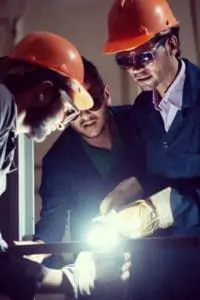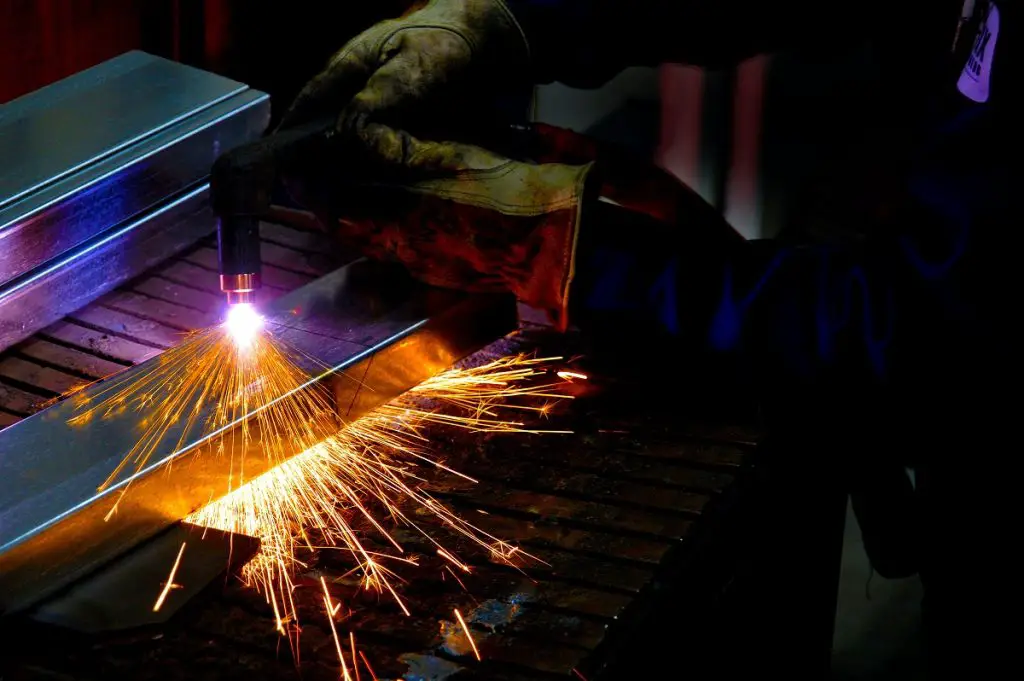Plasma cutters use electrically charged gas to cut through conductive materials with high speed, precision, and minimal heat-affected zones. Oxy/acetylene torches use a gas mixture to heat and cut materials, offering versatility in welding, brazing, and cutting, but at a slower pace and with less precision than plasma cutters.
If you are bootstrapping your new venture into welding, you may wonder which cutting system is best to start with.
There are other ways to cut steel without a plasma cutter or oxy/fuel torch. These include chop saws, hacksaws, angle grinders and pneumatically driven cut-off wheels.
Which of these tools ends up being the most practical depending on the thickness of the metal being cut and how much of it there is. You start hitting the limits of the pneumatic tools very quickly if your projects are of any size.
They have their place and can do some things very well. But, they are very limited in practicality. While the angle grinder with a cutoff wheel is just a larger version of the pneumatic tool, they also have limitations.
Both types can cut straight lines but neither are very good at cutting short radius curves.
On the other hand, chop saws can cut thicker steel much faster. They are good at cutting angles but can only make straight cuts. And a hacksaw will be good for only cutting the smallest of items.
An artist making small pieces of art might get by with just a hacksaw. But even then, they are severely limiting themselves if that is the only available tool.
What is a Plasma Cutter?
The plasma cutter uses electricity and gas under high pressure to cut through materials. As you might guess, the material being cut must be able to conduct electricity.
Thus limiting the materials that can be cut, to metals. Many metals can be cut but the most typical are steel, stainless steel, aluminum, brass, and copper.
The gas used varies depending on the metal being cut. For cutting steel, compressed gas, or air is typically supplied by a simple shop air compressor.
The actual cutting process entails the creation of an electrical pathway of superheated, electrically ionized gas, or plasma, originating from the torch and jetting through the metal to be cut.
The electricity completes its circuit back to the plasma cutter through the grounding clamp attached to the workpiece. The compressed air is blown through the focused nozzle in conjunction with the electrical arc is what creates the plasma and also pushes the molten metal away.
The electrical arc ionizing parts of the gas is what actually forms the plasma.
Check out this video from Hobart about plasma cutting:
What type of work does the plasma cutter perform best?
Plasma cutters produce a very thin stream of superhot plasma to cut with. This means the surrounding metal near the cut is not exposed to much heat during the cutting process.
This works out well for auto body work in addition to all work done on thinner metals which might warp if too much heat is introduced during the cutting process.
The narrow cut is very precise, leaving a smooth edge. This lends itself for the plasma torch to easily be attached to a computerized axial cutting table with which very intricate cuts can be made quickly.
Also known as a CNC table, these devices can cut multiple pieces that are identical, wasting very little of the original sheet. Or, they can be used to cut one-off pieces of very intricate, highly detailed work designed in a computer program.
 What else do I need before I can start using a plasma cutter?
What else do I need before I can start using a plasma cutter?
Assuming you will be starting out with one of the smaller, entry-level machines, you will need a 230v outlet and an air compressor with sufficient output to accommodate the needs of your particular plasma torch.
You can purchase a plasma cutter with a built-in compressor that will run on 120v but I am wary of them. When you decide you need a Plasma cutter, save for a more powerful unit.
You will need leather gloves, an apron or a jacket for protection from the heat and sparks.
I personally prefer a welding jacket like this one by Lincoln Electric. It is designed especially for high-amperage welding and out-of-position welding. It has a two-part armpit design that actually allows you to move your arms which is much more comfortable than the old-fashioned leather jackets.
Green-tinted filters for eye protection are recommended. Longevity Global Inc. created the chart below for guidance:
| Current Level in Amps | Minimum Shade Number |
|---|---|
| Below 20 | #4 |
| 20-40 | #5 |
| 40-60 | #6 |
| 60-80 | #8 |
For welding helmets with adjustable shading that can be used with a plasma torch, go here!
What is an Oxy/Acetylene Torch?
Invented in 1903 by two Frenchmen, oxy/fuel welding began as a means to fuse metal by combining pure oxygen and a fuel gas such as acetylene. Pure oxygen is used to increase the heat generated from the flame.
The acetylene/oxygen mixture burns at over 6,300 degrees Fahrenheit.
Forged welding is the second oldest welding process next to oxy/fuel welding. Since the advent of arc welding, very little industrial work is still performed with the oxy/fuel process. Artisans still use the method for creating artwork.
When the cutting torch head is attached to the oxy/acetylene handle, it becomes a powerful instrument for cutting metals. The focused flame from the end of the torch tip pre-heats the metal until cherry red.
A blast of pressurized oxygen then increases the heat substantially and blows the molten metal directly away from the tip. The initial torch flame only starts the process.
The blast of oxygen causing the formation of iron oxide, literally causing the metal to burn, creates the extra heat necessary to cut through the metal. The torch is then moved along a determined path until the cut is finished.
The molten metal blown from the piece being cut is called slag. When the oxy/fuel mixture is adjusted correctly, a clean cut can be made without leaving very much slag attached to the base metal.
One key to a quality cut is starting with a clean tip on the torch. This includes the nozzles. A small tip cleaning kit with an assortment of cleaning wire sizes is a must.

What else do I need before using an oxy/acetylene torch?
Besides the handle and cutting head attachment, you will need:
- Gas hoses, one red and one green
- Two regulators, one for the oxygen bottle and one for the acetylene bottle
- A bottle of oxygen
- A bottle of acetylene
- A striker for igniting the flame
- Tinted goggles, glasses or hood for eye protection
- Gloves, apron or jacket to protect from the molten slag
- A secure cart or area to store the bottles
- A safe place to work
- A tip cleaner
Fortunately, most of the above can be purchased in a package. First, determine the best size torch for your immediate and future needs and choose the package accordingly.
The Victor Medium Duty Torch kit is a great torch that will handle almost everything the hobby shop welder will ever encounter.
Your local welding supply store will gladly rent oxygen and acetylene bottles to you.
So which one do I recommend?
The choice is easy. For my purposes, and I believe most of yours, the oxy/fuel torch system is the way to go for your first buy. Like me, you may want to add a plasma cutter at some point in the future as your work progresses.
Purchasing the above kit and renting bottles will be cheaper initially than getting set up with a plasma cutter. Plus, the additional things you can do with an oxy/fuel torch outweigh the limited abilities of a plasma cutter.
For instance:
- You can’t warm up a rusty bolt or nut to aid in its extraction with a plasma cutter.
- One cant heat metal to the point where it can be bent or reshaped with a plasma cutter.
- You can’t burn debris and paint off metal with a plasma cutter


